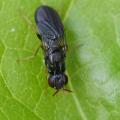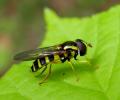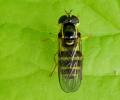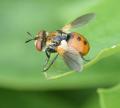|
Fly - with typical head (Platycephala planifrons)
|
|
| ebbek |
Posted on 08-08-2014 10:03
|
|
Member Location: Posts: 1410 Joined: 23.06.08 |
A fly from a marshy meadow in SW Sweden yesterday. Thankful för help to genera (or species). Regards Krister Edited by ebbek on 08-08-2014 17:04 |
|
|
|
| ebbek |
Posted on 08-08-2014 10:07
|
|
Member Location: Posts: 1410 Joined: 23.06.08 |
Other view. I can make better photos later if needed. |
|
|
|
| tristram |
Posted on 08-08-2014 13:35
|
|
Member Location: Posts: 1327 Joined: 27.06.10 |
It looks like a Platycephala sp (Chloropidae) but I am not an expert. |
|
|
|
| ebbek |
Posted on 08-08-2014 17:05
|
|
Member Location: Posts: 1410 Joined: 23.06.08 |
Many thanks - I am sure it is correct! It helps me to P. planifrons. |
|
|
|
| von Tschirnhaus |
Posted on 18-08-2014 18:48
|
|
Member Location: Posts: 429 Joined: 04.11.07 |
Platycephala planifrons (Fabricius, 1798), male, Chloropidae. The length of the projecting frons and the shape of 3rd antennal segment are characteristic. The different species are not always easy to distinguish and identification should be confirmed by checking the male genitalia after the article of Beschovski (1980): Acta zoologica bulgarica 15: 72-76. Larvae develop in reed stems resulting in the die-off of the whole stem and all leaves above the single larva. Dmitry Gavryushin gave a very good short summary of the biology in http://www.dipter...ad_id=2691! Larvae are feeding on bacteria which develop at the growing point of the Phragmites stem/leaves. Compare notes for further pictures of this species. Many publications exist on this species. Two species only occur in Scandinavia. |
|
|
|
| ebbek |
Posted on 29-08-2014 16:51
|
|
Member Location: Posts: 1410 Joined: 23.06.08 |
Thanks a lot for interesting information! |
|
|
|
| Jump to Forum: |














 but don't see the image in the post.
but don't see the image in the post.
